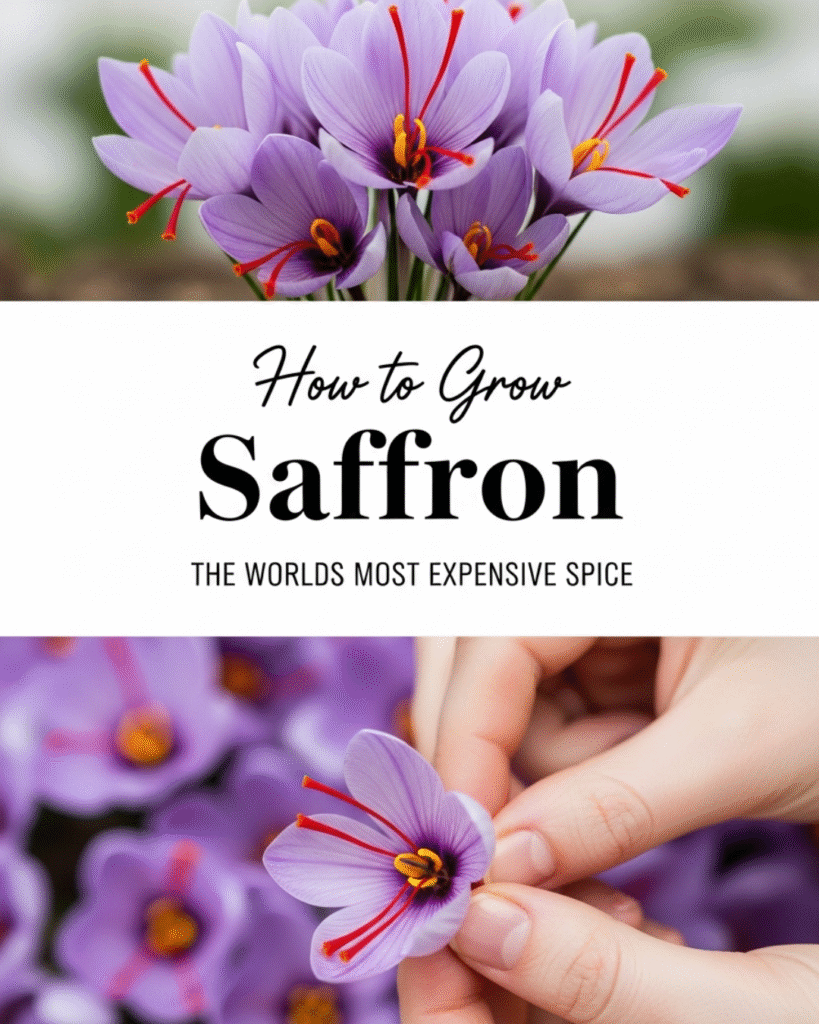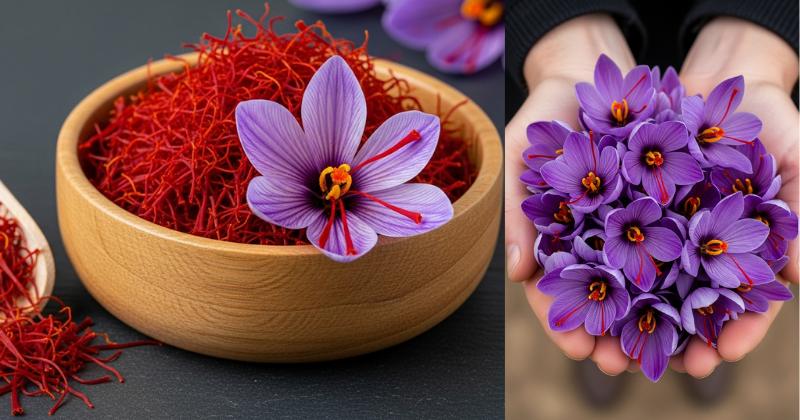Saffron, often called “red gold,” is the most expensive spice by weight in the world, renowned for its distinctive flavor, brilliant color, and potent antioxidant properties. While its high price tag might suggest it’s reserved only for expert farmers, the truth is that learning how to grow saffron is a surprisingly achievable goal for the home gardener! Saffron comes from the stigma of the Saffron Crocus (Crocus sativus), a beautiful fall-blooming flower. You don’t need a huge field; you can easily transform a small patch of garden or even a container into a saffron farm, providing you with a fresh, pure supply. This comprehensive guide will discover the exact steps you need, from choosing the right bulbs to the delicate art of harvesting the stigmas, empowering you to achieve homegrown luxury.

🌻 Foundation First: Understanding the Saffron Crocus
Before you dive into planting, it is essential to grasp the unique nature of the Saffron Crocus. This is not the same as the ornamental crocuses that bloom in the spring; the Saffron Crocus is a fall-blooming species and requires specific conditions.
H3: The Anatomy of Saffron and Its Timing
The spice we call saffron is the three bright red stigmas found inside the purple flower of the Crocus sativus. These tiny threads must be hand-harvested, which is why the spice is so costly.
- It’s a Corm, Not a Bulb: The Saffron Crocus grows from a corm, which is essentially a swollen underground stem that stores nutrients. This corm is the single most important purchase you will make.
- Planting and Blooming: Unlike most plants, Saffron Crocus is planted in the late summer (August to early September) and blooms relatively quickly in the fall (late October to November). It then rests through the winter and returns to bloom again the following fall.
- Perennial Growth: Saffron is a perennial plant. Once planted, the mother corm will produce “cormlets” (baby corms), gradually multiplying over several years, rewarding your initial effort with more flowers each season.
H3: Site Selection and Soil Requirements
The success of growing saffron hinges on replicating its Mediterranean origins: full sun and excellent drainage.
- Sunlight: Saffron needs full sun—at least six hours of direct sunlight daily—to thrive and produce robust flowers. Avoid shaded areas completely.
- Soil: The most common mistake when trying to grow saffron is poor drainage. The corms rot quickly in soggy soil. You must use sandy, loamy soil that is rich in organic matter but drains exceptionally fast. If your native soil is heavy clay, planting in raised beds or containers is the best way to guarantee success.
- Hardiness Zone: Saffron Crocus thrives in USDA Hardiness Zones 6 through 9, where it can experience cool winters and hot, dry summers.
🪴 Step-by-Step Process: Planting and Nurturing Saffron Corms
The key to learning how to grow saffron successfully is proper timing and planting depth for the corms.
Core Methods: The Planting Process
- Source the Corms: Purchase Saffron Crocus corms from a reputable dealer in late summer. Ensure they are guaranteed disease-free. Larger corms (over 10 cm in circumference) are more likely to bloom in the first year. Aim to plant them immediately after purchasing.
- Prepare the Bed/Container: If using the ground, amend the soil heavily with compost and grit (sand or perlite) to improve drainage. If using containers, select a deep pot (at least 10 inches deep) with ample drainage holes, using a high-quality, sandy potting mix.
- Planting Depth and Spacing: Plant the corms with the pointed side facing up, 3 to 4 inches deep and spaced 2 to 4 inches apart. Deeper planting helps protect them from harsh winter cold and discourages early cormlet formation, focusing energy on the first year’s bloom.
- Initial Watering: Water once immediately after planting to settle the soil. Do not water again until you see green shoots emerge in the fall, or if the region experiences an extreme, prolonged drought. Overwatering is the single greatest threat to your corms.
H4: Seasonal Care and Dormancy
Saffron requires minimal care after planting, making it a very hands-off crop until harvest time.
- Summer Dormancy: From spring (when the grass-like foliage dies back) until the fall bloom, the corms are dormant. They require heat and dryness during this time to set flower buds. Do not water during the dry summer months.
- Fall Growth: In the fall, grass-like leaves will emerge, followed shortly by the purple flowers. Once the foliage appears, you can water occasionally during prolonged dry spells, ensuring the soil dries out fully between watering.
(Internal Linking Opportunity: For beginners gardening tips, see our article, “Easy Guide to Amending Clay Soil for Better Drainage.”)
🌷 Advanced Strategies: Harvesting and Curing the Spice
The true skill in learning how to grow saffron lies in the meticulous, labor-intensive harvest, which requires precision and careful timing.
H3: The Precision of the Harvest
Saffron flowers are extremely fleeting. The plant will bloom for a window of about two to four weeks in the fall, and the flowers often last only a single day.
- When to Harvest: You must harvest the flowers on the morning they open, ideally just after the dew has dried but before the heat of the midday sun. This ensures the maximum concentration of flavor compounds (safranal) in the stigmas.
- How to Harvest: Carefully pluck the entire flower from the stem. Immediately take the flower indoors. Gently open the purple petals and use small tweezers or clean fingers to pinch the three red stigmas from the yellow style. The whole red thread is the spice; discard the rest of the flower.
- Yields: Don’t be discouraged by the small yield! It takes about 150 flowers to produce one gram of dried saffron. For home use, a planting of 50 to 100 corms is usually enough to enjoy the spice for a year.
H3: Curing and Storing Your Red Gold
The delicate stigmas must be cured (dried) immediately after picking to preserve their flavor, aroma, and color.
- Curing: Lay the freshly picked stigmas on a small sheet of parchment paper. Place the parchment paper on a warm (not hot!) surface, such as a heating pad set on low, a low oven rack (no more than 120°F/50°C), or a food dehydrator.
- Drying Goal: The goal is to reduce their moisture content by about 80%. They are fully dry when they feel brittle and break easily between your fingers. This usually takes between 20 to 60 minutes, depending on the heat source.
- Storage: Store the dried saffron in a small, airtight, dark container, away from light, heat, and humidity. Saffron is best used 3-12 months after curing, as the flavor intensifies during this period.
🐌 Troubleshooting and Common Challenges
While growing saffron is relatively straightforward, you may encounter issues that prevent a robust harvest.
Featured Snippet Potential: “Why did my Saffron Crocus bulbs not flower in the fall?”
Your Saffron Crocus corms likely did not flower in the fall for one of two main reasons: insufficient chilling during the previous winter, or poor drainage leading to corm rot. The plant needs several weeks of cold dormancy (Zones 6-9) to set flower buds. If corms are planted in soggy, heavy soil, they will rot before the fall bloom period. Ensure you planted in late summer and that the soil is exceptionally well-draining. You may also need to wait until the second year, as smaller corms often require a year to mature before their first bloom.
Practical Solutions for Saffron Problems
- Pest Threat (Voles/Mice): Rodents love to eat corms, especially in the winter. Preventive Measure: Plant the corms inside wire mesh cages (hardware cloth) buried beneath the soil, or plant in deep containers that pests cannot easily access.
- Leaf Spotting: This is often a sign of fungal infection, typically due to excessive moisture. Solution: Reduce watering dramatically. Improve air circulation around the plants and apply a general-purpose organic fungicide if necessary, but water management is the best defense.
- No Second-Year Bloom: If the plant bloomed the first year but not the second, the cormlets may be too crowded, causing reduced vigor. Solution: Every 3-5 years, you should carefully lift and divide the corms during the summer dormancy period (July/August). Replant the largest corms, and share the rest!
📈 Maximizing Results: Scaling and Long-Term Care
Once you master how to grow saffron on a small scale, you can easily replicate your success and enjoy a consistent, growing harvest year after year.
Long-Term Bed Management
- Weed Control: Because Saffron Crocus is dormant during the summer, the garden bed is susceptible to weeds. Keep the area around the corms clean. Weeds compete for nutrients and water and make the fall harvest more difficult.
- Fertilization: Saffron is a heavy feeder, but only when actively growing. Apply a low-nitrogen, high-potassium fertilizer once in the early fall when the leaves first emerge. Avoid high-nitrogen fertilizers, which encourage foliage growth over flower production.
- Corm Renewal: Remember to lift and divide your corms every few years during the summer dormancy. This is key to long-term productivity and prevents overcrowding that can stop the blooming. You can easily start new beds or give corms to friends!
By mastering the environmental connection—lots of sun, dry summers, and cold winters—you ensure the corms multiply and produce those coveted, delicate stigmas, allowing you to discover the full potential of your saffron patch.
✨ Conclusion: Your Culinary Gold Is Waiting
You have learned the essential knowledge for how to grow saffron, debunking the myth that this spice is reserved only for distant climates. By focusing on the unique needs of the Saffron Crocus—planting the corms deep in late summer, ensuring exceptional drainage, and patiently awaiting the fleeting fall bloom—you have gained the power to cultivate your own supply of “red gold.”
The small effort required for harvest is a rewarding connection to history and nature, empowering you to add the authentic flavor and vibrant color of homegrown saffron to your culinary creations. Go ahead and start planting those corms!
Which classic dish, like paella or risotto, will you make first with your fresh, homegrown saffron?
